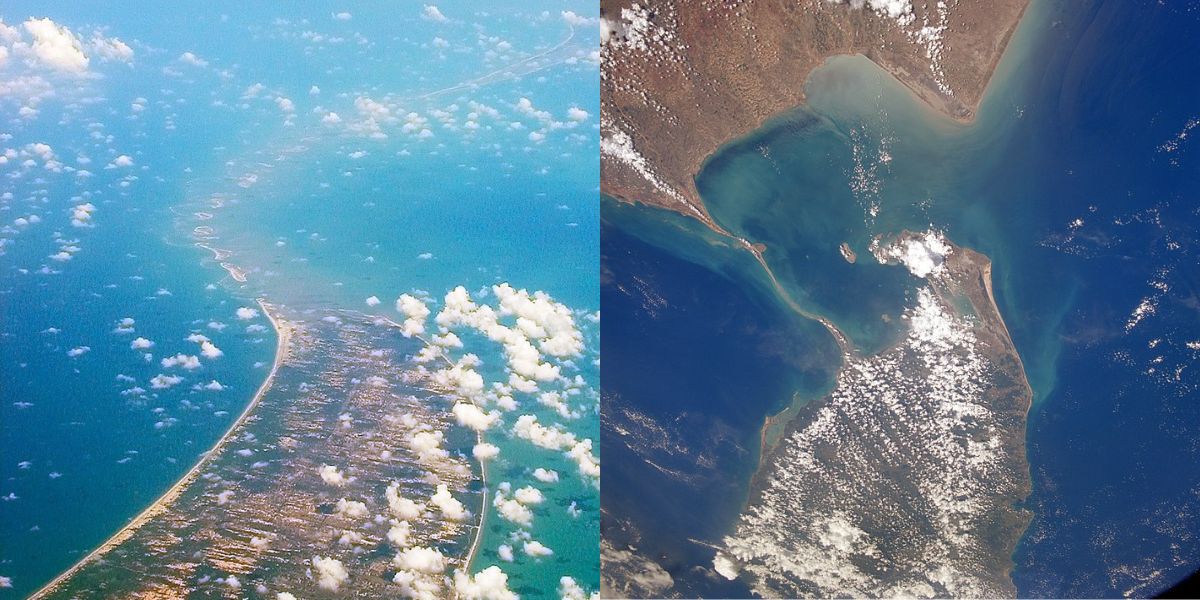The plea sought the construction of a wall at the site, which was also rejected by the apex court, saying these were administrative matters.
Published Oct 03, 2023 | 2:28 PM ⚊ Updated Oct 03, 2023 | 2:28 PM

Ram Sethu. (Creative Commons)
The Supreme Court refused to entertain a plea seeking directions to declare Ram Sethu as a national monument on Tuesday, 3 October.
The plea also sought the construction of a wall at the site, which was also rejected by the apex court, saying these were administrative matters for the government.
Ram Sethu, also known as Adam’s Bridge, is a chain of limestone shoals between Pamban Island off the south-eastern coast of Tamil Nadu, and Mannar Island off the north-western coast of Sri Lanka.
According to Hindu mythology, the Ram Sethu was built by the army led by Hanuman to help Rama rescue Sita from Ravana.
The plea came up for hearing before a bench of Justices Sanjay Kishan Kaul and Sudhanshu Dhulia. The petition was filed by an organisation named Hindu Personal Law Board through its president Ashok Pandey.
Pandey, who is also an advocate, informed the bench about a plea filed by BJP leader Subramanian Swamy which was pending in the apex court.
In his plea, Swamy sought a direction to the Centre to declare Ram Sethuas a national heritage monument.
Pandey urged the bench that the plea filed by the board be tagged with Swamy’s pending petition.
“If it is pending, it is pending. What do you want?” the bench asked.
When he referred to his prayer for the construction of a wall at the site, the bench observed, “How can a wall be constructed on two sides?”
“Is this for the court to do? These are administrative matters for the government. Why should we get into this?” the apex court said.
The bench refused to accede to the petitioner’s request that his plea be tagged with the pending petition.
“We are not inclined to exercise jurisdiction under Article 32 of the Constitution of India to give any nature of direction as the petitioner seeks,” the bench said while refusing to entertain the plea.
Article 32 of the Constitution deals with remedies for the enforcement of rights and 32 (1) says that the right to move the apex court by appropriate proceedings for the enforcement of rights conferred by this part is guaranteed.
The plea filed by the board sought the top court’s direction to authorities concerned to construct a wall at the Ram Sethu site.
It also sought a direction for declaring Ram Sethu as a national monument within the provisions of the Ancient Monuments and Archaeological Sites and Remains Act, 1958.
In January this year, Tamil Nadu Chief Minister MK Stalin called for the revival of the Sethusamudram Ship Channel project — through Ram Sethu — and the state Assembly unanimously adopted a resolution urging the Centre to come forward to immediately implement the project without any further delay.
Ever since the British announced the Sethusamudram ship canal project in 1860, it has been submerged in controversies. The issue came to the limelight recently when the Union government told the Supreme Court that it would not touch the bridge with mythological significance and would find an alternate route to complete the project.
The Centre’s response to the apex court was in reply to BJP leader Subramanian Swamy’s petition, which was filed in 2007 over the UPA government’s decision to go ahead with the Sethusamudram project.
“The Government of India intends to explore an alternative to the earlier alignment of Sethusamudram Ship Channel project without affecting/damaging the Adam’s Bridge/Ram Sethu in the interest of the nation,” the affidavit filed by the ministry had said.
Even the Tamil Nadu BJP supported the resolution — which is against the stand taken by the Centre — with a condition that Ram Sethu was not touched. The BJP’s Nainar Nagendran said his party would welcome it if it did not cause any damage to the Ram Sethu.
The main Opposition AIADMK said that the views of fishermen should be ascertained and past dredging work for the project should be analysed and if it was going to hugely benefit the people, it would support the project. Pollachi V Jayaraman spoke on behalf of his party.
Piloting the resolution, Chief Minister MK Stalin traced the timeline of the maritime project since the days of former chief minister CN Annadurai and the nation’s first prime minister Jawaharlal Nehru.
The project had the Nehru-led Cabinet nod in 1963 and was part of the Fourth Five-Year Plan. Annadurai demanded the implementation of the project in 1967 after becoming the chief minister. Annadurai, popularly known as Anna and Perarignar (great scholar), is an iconic leader and founder of the DMK.
Stalin recalled that in 1972, late chief minister M Karunanidhi had urged the then prime minister Indira Gandhi to implement the project.
In 1998, when Atal Bihari Vajpayee was the prime minister, fund allocation was made for the project work, and the alignment was chosen.
In 2004, after the Congress-led UPA captured power, ₹2,427 crore was allotted, and when the project work was half-complete, the BJP’s opposition to it became a stumbling block.
Stalin said the late AIADMK supremo, J Jayalalithaa, who had supported the project from the start, suddenly changed her stand and knocked on the doors of the court against it.
Had there been no political stumbling blocks, there would have been a lot of benefits after the project’s commissioning about 10 years ago, he said.
The government resolution said that the “Sethusamudram project is essential to strengthening the economic development of Tamil Nadu and India”.
It recalled that the ‘great project’ was originally conceived in 1860 by Commander Taylor at a cost of ₹50 lakh. On 2 July, 2005, then Prime Minister Manmohan Singh inaugurated the project in the presence of Karunanidhi and Sonia Gandhi.
(With PTI inputs)
